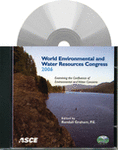Rainwater Harvesting, Low Impact Development Strategies, and Meeting the National Pollution Discharge Elimination System (NPDES) Stormwater Discharge Standards
Publication: World Environmental and Water Resource Congress 2006: Examining the Confluence of Environmental and Water Concerns
Abstract
The National Pollution Discharge Elimination System (NPDES) was established to control development generated pollutants that are discharged into natural drainage systems. NPDES regulates point source pollution that enters surface bodies of water including water pollutants such as effluent from factories, power plants, sewage treatment plants, large construction sites, storm sewer systems, and stormwater runoff. Stormwater runoff—the main subject of the paper—is listed with these other toxic water sources because it too can have extremely poor water quality by picking up and removing toxins from an urban environment as it moves through a developed site. The larger the development, the more essential it is to deal with its generated pollutants. Rainwater harvesting deals with the rain that falls on a site and can be either a passive system allowing gravity to do the work or can be an active system where the rainwater is collected in cisterns for future use. Stormwater can be collected off rooftops or ground level catchments. The water can be used for either non-potable or potable uses. Water collection alone can not remove the threat of stormwater pollutant transport however; combining collection with low impact development strategies increases the potential for eliminating stormwater transport of pollutants. Low impact development strategies deal with the way a site is designed and graded and deals with strategies such as reducing impervious areas, using permeable pavements, eliminating curbs or allowing stormwater to move through curbs, or installing strategies such as rain gardens and bioswales. Responsible stormwater management incorporates rainwater harvesting and low impact development strategies to help streamline NPDES requirements. This paper discusses a common goal in green building development projects, which is to generate "no net" increase in runoff from a site and improve water quality of stormwater that must leave the site. This goal is met with two basic concepts: rainwater harvesting and low impact development strategies. Along with a description of the two basic concepts, a stormwater case study is provided at the end of this paper to demonstrate applicability.
Get full access to this chapter
View all available purchase options and get full access to this chapter.
Information & Authors
Information
Published In
Copyright
© 2006 American Society of Civil Engineers.
History
Published online: Apr 26, 2012
ASCE Technical Topics:
- Business management
- Drainage
- Drainage systems
- Environmental engineering
- Hydrologic engineering
- Irrigation engineering
- Pollutants
- Pollution
- Practice and Profession
- Rain water
- Stormwater management
- Sustainable development
- Water (by type)
- Water and water resources
- Water discharge
- Water management
- Water pollution
- Water quality
- Water treatment
Authors
Metrics & Citations
Metrics
Citations
Download citation
If you have the appropriate software installed, you can download article citation data to the citation manager of your choice. Simply select your manager software from the list below and click Download.
